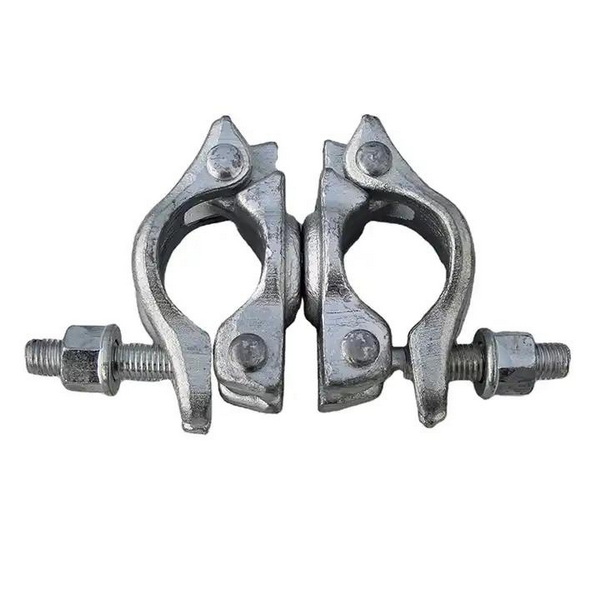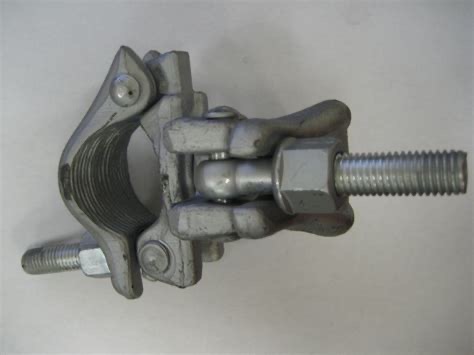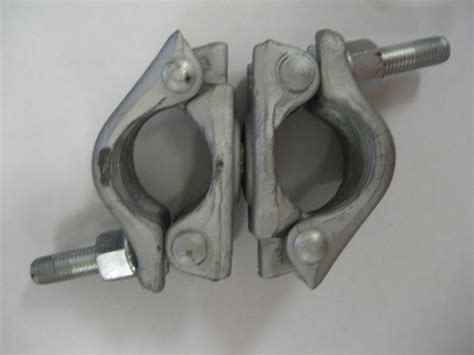Content Menu
● What is a Clamp Scaffolding Swivel?
● Key Components and Design
● How Clamp Scaffolding Swivels Work
>> 1. Swivel Mechanism
>> 2. Load Distribution
● Applications in Modern Construction
>> 1. Diagonal Bracing
>> 2. Temporary Access
>> 3. Complex Geometries
● Step-by-Step Installation Guide
>> Tools Required:
● Safety Standards and Compliance
● Comparison with Right-Angle Clamps
● Advanced Tips for Using Clamp Scaffolding Swivels
● Common Mistakes to Avoid
● Environmental and Economic Benefits
>> Environmental Impact
>> Economic Advantages
● Conclusion
● FAQ
>> 1. Can clamp scaffolding swivels replace right-angle clamps?
>> 2. What torque is required for clamp scaffolding swivels?
>> 3. Are clamp scaffolding swivels suitable for heavy loads?
>> 4. How do I prevent clamp scaffolding swivels from slipping?
>> 5. Can clamp scaffolding swivels be reused?
Clamp scaffolding swivels are essential components in modular scaffolding systems, enabling workers to connect tubes at virtually any angle. These versatile couplers provide unmatched flexibility for constructing scaffolds on uneven terrain, curved structures, or complex architectural designs. In this guide, we'll explore the mechanics, applications, and safety protocols of clamp scaffolding swivels, supported by visual aids and real-world examples.

What is a Clamp Scaffolding Swivel?
A clamp scaffolding swivel (also called a swivel coupler) is a forged steel or aluminum device that connects two scaffold tubes at adjustable angles. Unlike fixed right-angle clamps, swivels allow for dynamic configurations, making them ideal for diagonal bracing, curved structures, and irregular layouts.
Key Features:
- Adjustable angles (0–180°)
- Compatible with standard 48.3mm tubes
- Hot-dip galvanized for corrosion resistance
- Load-rated for safety (typically 6.25 kN)
Key Components and Design
- Swivel Head: Rotates 360° for angle adjustments.
- Bolts and Nuts: High-tensile steel (Class 8.8) tightened to 45 ft.-lbs.
- Jaws: Serrated grips prevent tube slippage.
- Body: Drop-forged steel for durability.
- Standard Swivel: For general bracing and connections.
- Heavy-Duty Swivel: Higher load capacity (up to 15 kN).
- Galvanized Swivel: Corrosion-resistant for outdoor use.
How Clamp Scaffolding Swivels Work
1. Swivel Mechanism
The clamp's two interconnected halves rotate independently, allowing tubes to be locked at any angle. Once positioned, bolts are tightened to secure the joint.
Process:
1. Align tubes at the desired angle.
2. Position the swivel clamp over both tubes.
3. Tighten bolts to 45 ft.-lbs using a torque wrench.
2. Load Distribution
Swivel clamps distribute weight evenly across connected tubes, resisting both compression and tension forces. Their serrated jaws grip tubes securely, even under vibration or wind loads.
Applications in Modern Construction
1. Diagonal Bracing
Swivel clamps are critical for installing diagonal braces, which stabilize scaffolds against lateral forces.
- Architectural Features: Domes, vaulted ceilings.
- Bridge Maintenance: Scaffolds on inclined surfaces.
2. Temporary Access
- Event Stages: Flexible layouts for lighting rigs.
- Industrial Plants: Custom platforms around machinery.
3. Complex Geometries
Swivel clamps are indispensable for creating scaffolds on irregular or non-orthogonal structures, such as towers, chimneys, or ship hulls.

Step-by-Step Installation Guide
Tools Required:
- Swivel clamps
- Torque wrench (45 ft.-lbs)
- Level
- Scaffold tubes
Steps:
1. Inspect Components: Check for cracks or corrosion.
2. Position Tubes: Align at the desired angle.
3. Attach Clamp: Slide swivel jaws over both tubes.
4. Tighten Bolts: Use a torque wrench for consistent pressure.
5. Verify Stability: Ensure no movement under load.
Safety Standards and Compliance
Swivel clamps must meet:
- EN 74: European standard for slip resistance and load capacity.
- OSHA 1926.451: U.S. requirements for scaffold stability.
- BS 1139: British specifications for materials.
Critical Checks:
- Torque consistency (re-tighten after 24 hours).
- No visible deformation or rust.
- Compatibility with tube diameters.
| Clamp Type | Safe Working Load (SWL) | Maximum Angle |
| Standard Swivel | 6.25 kN | 180° |
| Heavy-Duty Swivel | 15 kN | 180° |
Checklist:
- Inspect for cracks, deformation, or excessive rust.
- Ensure bolts and nuts are not stripped.
- Test grip by applying moderate force to connected tubes.
Comparison with Right-Angle Clamps
| Feature | Swivel Clamp | Right-Angle Clamp |
| Flexibility | Adjustable angles | Fixed 90° only |
| Use Case | Bracing, curves | Corners, right-angle joints |
| Load Capacity | Lower | Higher |
| Ease of Use | Requires skill | Simple |
| Cost | Slightly higher | Lower |
Advanced Tips for Using Clamp Scaffolding Swivels
- Standardize Inventory: Use compatible brands and types for easier assembly and maintenance.
- Double Up on Bracing: For high-wind or high-load areas, use two swivels per joint for redundancy.
- Mark Angles: Use a marker or angle finder to ensure precise alignment for complex geometry.
- Use Anti-Seize Lubricant: Prevents galling and eases future disassembly.
- Train Workers: Ensure all installers are familiar with torque requirements and inspection protocols.
Common Mistakes to Avoid
- Over-Tightening: Can strip bolt threads or deform the clamp.
- Mixing Clamp Types: Compromises structural integrity; always use the correct clamp for each joint.
- Ignoring Corrosion: Weakens clamp strength and can lead to sudden failure.
- Improper Storage: Leaving clamps exposed to the elements accelerates rusting.
- Skipping Inspections: Failing to check clamps before use can result in dangerous conditions.
Environmental and Economic Benefits
Environmental Impact
- Recyclability: Steel and aluminum clamps are 100% recyclable.
- Longevity: With proper maintenance, clamps can be reused for decades, reducing waste.
Economic Advantages
- Labor Savings: Swivel clamps speed up assembly for complex scaffolds, reducing labor costs.
- Reduced Replacement: Durable, corrosion-resistant clamps require less frequent replacement, saving money in the long term.
- Versatility: One type of clamp can be used for multiple applications, minimizing inventory needs.
Conclusion
Clamp scaffolding swivels are indispensable for modern construction, offering unparalleled adaptability for complex projects. Their ability to connect tubes at any angle makes them the go-to solution for diagonal bracing, curved scaffolds, and irregular structures. By adhering to torque specifications, load limits, and safety standards, these clamps ensure stable, durable scaffolding systems. With proper maintenance and training, clamp scaffolding swivels empower builders to tackle challenging environments safely and efficiently, making them a cornerstone of safe, flexible, and cost-effective scaffolding design.

FAQ
1. Can clamp scaffolding swivels replace right-angle clamps?
No-swivel clamps are for angled connections, while right-angle clamps provide rigid 90° joints. Both are essential for different parts of a scaffold.
2. What torque is required for clamp scaffolding swivels?
Tighten to 45 ft.-lbs using a calibrated wrench for optimal grip and safety.
3. Are clamp scaffolding swivels suitable for heavy loads?
Heavy-duty swivels support up to 15 kN, but right-angle clamps are better for primary load-bearing joints. Always check manufacturer specifications.
4. How do I prevent clamp scaffolding swivels from slipping?
Ensure serrated jaws grip tubes fully, use the correct torque, and re-tighten after 24 hours of use.
5. Can clamp scaffolding swivels be reused?
Yes, if undamaged and properly maintained. Replace immediately if cracks, deformation, or excessive corrosion are detected.






















